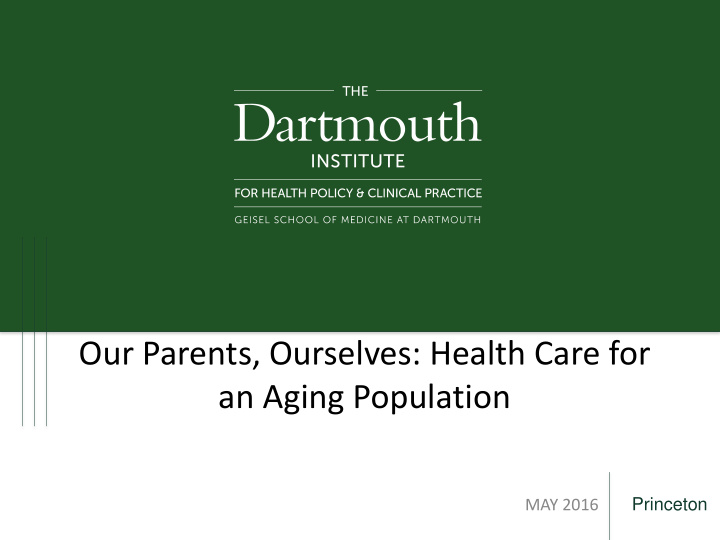



Our Parents, Ourselves: Health Care for an Aging Population MAY 2016 Princeton
Variations in Practice and Spending The Dartmouth Atlas tdi.dartmouth.edu
Motivation for Current JAHF- Funded Report • Health Care for Aging Population requires attention to the populations special characteristics and needs • Report Covers: – Population characteristics – Areas where benefits/risks & preferences important – Indicators for how interact with health system – Areas showing improvement – Focus on dementia and multiple chronic conditions tdi.dartmouth.edu
Percent of U.S. population age 75 years and older, by HRR (2012) Population Characteristics 7 .4% to 17 .1% (61) 6 .7% to < 7 .4% (56) 6 .1% to < 6 .7% (60) 5 .3% to < 6 .1% (64) 2 .7% to < 5 .3% (65) Not populated tdi.dartmouth.edu
Percent of male Medicare beneficiaries age 75+ receiving a screening PSA test, by HRR (2012) Benefit/Harm with Age: Guidelines recommend against screening men over 75 22 .0% to 30 .0% (62) 19 .6% to < 22 .0% (63) 18 .0% to < 19 .6% (59) 15 .6% to < 18 .0% (61) 9 .8% to < 15 .6% (61) Not populated
Percent of Medicare decedents enrolled in hospice care during the last three days of life, by HRR (2012) Preferences matter: Late identification and referral limits potential benefits of Hospice 20 .0% to 27 .4% (63) 17 .4% to < 20 .0% (62) 15 .4% to < 17 .4% (59) 13 .3% to < 15 .4% (61) 6 .0% to < 13 .3% (61) Not populated
Percent of Medicare beneficiaries readmitted within 30 days following medical discharge, by HRR Areas of Improvement: Readmission declining lower but still room to improve 20 days following discharge for medical conditions Percent of beneficiaries readmitted within 30 19 18 17 16 15 14 13 12 11 10 2008 2010 2012 U.S. average 16.2% 15.9% 15.5%
Number of days spent in inpatient settings among three patient cohorts, by HRR (2012) Special Populations: Multiple Chronic Conditions or Dementia 40 Inpatient days per Medicare beneficiary 35 30 25 20 15 10 5 0 All Multiple chronic beneficiaries conditions Dementia U.S. average 4.6 17.2 22.5
Number and source of contact days for Medicare beneficiaries in Lebanon, NH, and East Long Island, NY (2012) How many days of the year does the average FFS Medicare beneficiary Leave the home to receive health care? (doctors visits, procedures, labs and imaging, inpatient days) National Average: 17 days 3 ½ business day weeks Minimum: 10 days 2 business day weeks Maximum: 25 days 5 business day weeks People with Two or More Chronic Conditions National Average: 33 days 6 ½ business day weeks Minimum: 22 days 4 ½ business day weeks Maximum: 46 days 9 business day weeks
Number of contact days with the health care system among three patient cohorts, by HRR (2012) 48 44 the health care system per beneficiary Average number of contact days with 40 36 32 28 24 20 16 12 8 All Multiple chronic beneficiaries conditions Dementia U.S. average 17.1 33.2 29.6
Percent of beneficiaries who had a primary care physician as their predominant provider of care, by HRR (2012) Interacting with Health System: Specialty of the Doctor seen most as outpatient 75 Percent of beneficiaries whose predominant 70 York, PA 73.4% provider was a primary care physician McAllen, TX 70.9% Jonesboro, AR 70.8% 65 Florence, SC 69.7% Youngstown, OH 68.7% 60 U.S. average 56.9% 55 Missoula, MT 45.8% Idaho Falls, ID 45.8% 50 New Orleans, LA 45.8% Gulfport, MS 43.4% 45 Metairie, LA 42.6% 40
Percent of beneficiaries who had a primary care physician as their predominant provider of care, by HRR (2012) Interacting with Health System: Specialty of the Doctor seen most as outpatient 62 .2% to 73 .4% (62) 59 .3% to < 62 .2% (61) 56 .4% to < 59 .3% (62) 52 .3% to < 56 .4% (60) 42 .6% to < 52 .3% (61) Not populated
Report & Interactive Data www.dartmouthatlas.org Questions about data atlas@dartmouth.edu My email: julie.bynum@dartmouth.edu
Recommend
More recommend